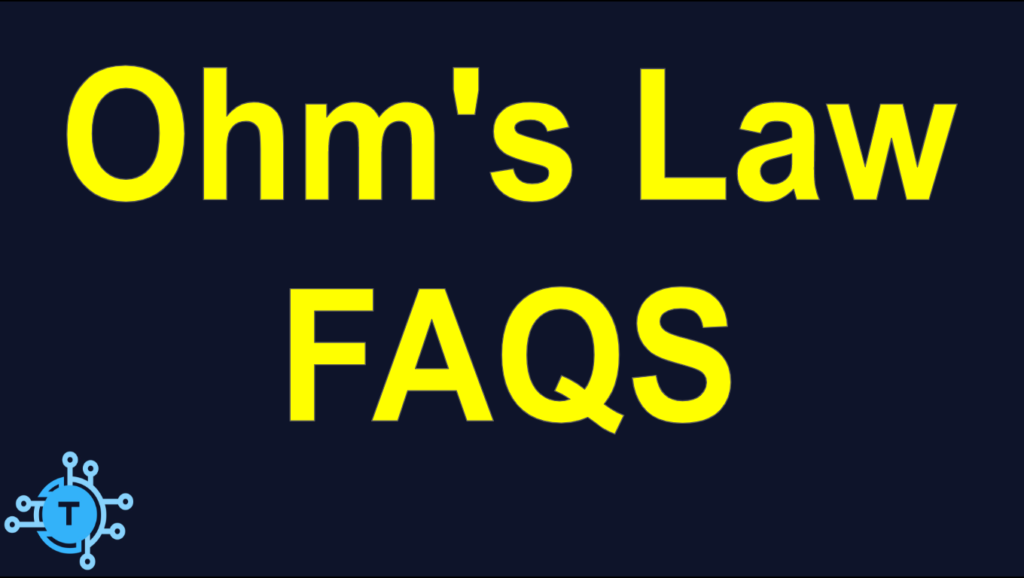
Frequently Asked Questions about Ohm’s Law is another in a series of FAQS about electricity and electronics that are oriented toward Appliance Technicians and HVAC Technicians.
Frequently Asked Questions about Ohm’s Law
Q. What is Ohm’s Law?
A. It is an empirically (via experimentation) established law which states that voltage, current, and resistance are mathematically related and proportional to each other in an electric circuit.
Q. Who established Ohm’s Law?
A. Ohm’s Law is based on the research of German physicist Georg Ohm in 1827.
Q. How do you use Ohms Law?
A. Ohm’s Law can be used to find Voltage (V or E) given Current (I) and Resistance (R) by using the formula E = I x R. Current can thus be found by I = E / R, and Resistance R = E / I.
Q. Can Ohm’s Law be used for DC and AC circuits alike?
A. Yes. When AC circuits use only resistive components, Ohm’s law can be used to directly by using AC RMS voltage and AC RMS current, along with said resistive components.
Q. Can Ohm’s Law also be used when reactive components such as inductors/motors, or capacitors are involved?
A. Yes, but in many cases one must use complex math and convert values to the frequency domain which takes phase shifts into account.
Q. What does it mean when one says that Ohm’s Law is proportional?
A. It means that if you double voltage, current doubles. Likewise if you double resistance, current is cut in half. There is a direct linear relationship between voltage, current, and resistance.
Q. What is the Ohm’s Law triangle?
A. It is just a visual representation of Ohm’s Law’s mathematical relationship between Voltage, Current, and Resistance, which makes it easy to remember and apply.
Q. What else can Ohm’s Law be used for?
A. It can be used for all manner of circuit analysis, including series and parallel circuits. Although voltages and currents in such circuit configurations have specific formulas, they are all derived from Ohm’s Law, and can still be broken down and calculated using Ohm’s Law in many cases, rather than the derived formulas. For example, voltages and currents in series and parallel circuits can all be calculated by simple Ohm’s Law, in a step-by-step manner, rather than using the series or parallel circuit formulas directly.
Q. How can Ohm’s Law be used to calculate the current and voltage drops in a series circuit with two resistors?
A. First, find the total resistance, which is the sum of the resistances. Then use Ohm’s Law to calculate the circuit current by dividing the source voltage by the total resistance ( I =V / Rt ). Since that current remains the same throughout the entire circuit, multiply that current by each resistor value to find the respective voltage drops ( VR1 = I x R1), ( VR2 = I x R2 ).
Q. How can Ohm’s Law be used to calculate the current in each branch of a parallel circuit with two resistors?
A. It is very simple. The voltage across each resistor in a parallel circuit is equal to the source voltage. The current through each resistor is that source voltage divided by the respective resistance. Hence, IR1 = V / R1, and IR2 = V / R2. The total circuit current is equal to the sum of all branch currents, so Itotal = IR1 + IR2.
Q. What is an example of using Ohm’s Law in field service?
A. Appliance Type: Electric dryer (with dual element). Symptom: Takes too long to dry. Ohm’s Law usage: Quickly determine whether one of the coils in the dual element is burned out without disassembling the dryer. The schematic calls out the resistances of each coil in the element. You can use Ohm’s law to determine the expected current through the L2 line (return path for the heat circuit) and know if only one, or both elements are energized. If the schematic called out the power, you could also use the power formula in conjunction with, or instead of Ohm’s law to do the same. If, for example, the high heat coil was called out at 15 ohms then the expected current should be I = 240v/15 ohms = 16A. If the low heat coil was called out at 38 ohms, the expected current would be 240v/38 ohms = 6A. Thus during low heat, you should expect 6A through L2 and on high heat, usually both coils are energized – since they are in parallel, you would add the currents of each coil for a total of 22A. So now you know what currents should be flowing through L2 for a given setting and can determine which, if any, of the coils are likely burned out.
To donate to the Tech Circuit – CLICK HERE
For additional electrical and electronics learning material for field techs, visit our homepage at http://www.TechCircuit.org or our Facebook group at https://www.facebook.com/groups/746823709133603 or our YouTube Channel
at https://www.youtube.com/@TheTechCircuit
TC
We are a participant in the Amazon Services LLC Associates Program, an affiliate advertising program designed to provide a means for us to earn fees by linking to Amazon.com and affiliated sites.
